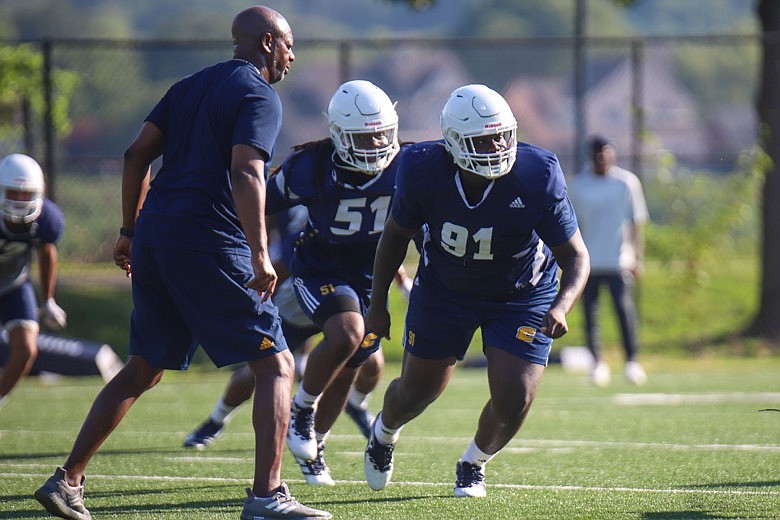The good folks at the NCAA are calling it "transformation." They even formed a "Transformation Committee" -- chaired by Southeastern Conference commissioner Greg Sankey and Ohio University director of athletics Julie Cromer -- to spearhead the agenda.
But like everything else about the NCAA these days, that term is misleading. Hugely so.
Instead of transformation it should be called obliteration. Because that's what's about to happen to college athletics as we've known it for decades. It's about to be obliterated, and it just might wind up obliterating intercollegiate sports at schools such as the University of Tennessee at Chattanooga.
"The (financial) gap is getting wider and wider," said UTC athletic director Mark Wharton on Friday afternoon, some 15 days before the Mocs were set to begin their 2022 football season by hosting Southern Conference foe Wofford at Finley Stadium.
"It's getting harder and harder for FCS (Football Championship Subdivision) schools like us to compete."
Whether they'll admit it or not, what many, if not all of the SEC schools Sankey oversees, as well as the majority of the Power Five programs in the Big Ten, Atlantic Coast, Big 12 and Pac 12 most want is to make it impossible for the UTCs of the world to compete.
They won't outwardly say it. They'll tap dance around it using words such as transformation and autonomy. They'll say it would be best for everyone to pass rules that make sense for their own bank accounts, kind of a live-within-your-means philosophy, which wouldn't be a bad idea for every aspect of American society.
Or as Georgia president Jere Morehead recently told Sports Illustrated: "I will tell you that I don't think it works well to have one D-I school with a budget of $10 million and another with a budget of $150 million and expect we can resolve those differences with some of the issues we have discussed."
Morehead's right, of course. UTC and Georgia have next to nothing in common when it comes to budgets other than they both will probably spend the majority of their budgets on football, since that sport has the largest number of athletes and coaches.
But it used to seem as if college athletics' power brokers would occasionally take pity on their less financially successful brothers. They'd play guarantee games to help out the less fortunate among them, especially within their own states, which is why Tennessee has so often placed UTC, or Tennessee Tech, or Austin Peay, or even Memphis on the schedule.
Now the opposite seems to be true. Let's push them aside as much as possible. Let's grab all the television revenue we can. In fact, let's go wall-to-wall television every Saturday to the point that almost all casual fans -- and let's face it: Once you get past the Power 5s, the vast majority of fan bases are somewhat casual -- will stay home to watch marquee matchup after marquee matchup. The rich get richer. Everybody else might go out of business.
It's not just football adopting a scorched earth policy, however. Among numerous ideas seriously being considered by the big boys is to fund full scholarships in so-called non-revenue sports such as baseball, softball, tennis, golf and wrestling.
Baseball, for instance, currently allows 11.7 scholarships to be divided among a total of 27 players on a 35-man roster. Every player on scholarship must have at least 25 percent of a full ride. But under the new transformation guidelines, there's an expected move to allow schools to award full rides to all 35 players if a school so chooses.
The results of such changes should be obvious. Other than Notre Dame, it's unlikely any school outside a Power Five conference could handle such an expense, and it's doubtful that a reasonable number of those could over time.
It would be one thing for Alabama, Georgia, Florida, Michigan, Ohio State, Southern Cal and Texas to award such scholarships across all sports. It would be quite another for Iowa State, Kansas State, Rutgers and Washington State to do the same.
But let's go back to UTC. The Mocs don't play baseball, but they've enjoyed much historical success in softball and women's basketball. If they're now going to have to provide full-ride scholarships for the entire softball team in order to be competitive, they're done.
And while none of the following is official, or even likely to happen, there's also a model out there that would slash a school's total sports programs to as few as eight, with the men fielding three teams and the women five in order to satisfy Title IX. In the South, those three men's sports might be football, basketball and baseball, money makers all. In parts of the Midwest, you might go with football, basketball and wrestling, In the Northeast, you might choose football, basketball and ice hockey.
Under such a blueprint, if football wanted 125 on full rides, no big deal. Want a men's basketball roster of 20? Go for it. Pile 35 into hockey? Have at it. The more the merrier because the television money could conceivably never run out, billions on top of billions paid to a select few. A very select few.
It was all enough to make longtime Iowa football coach Kirk Ferentz make the following observation at the recent Big Ten media day: "I think we're in a really precarious place. There's just a lot of vagueness, a lot of uncertainty. We don't have a basic set of operating rules."
Which is just the way the haves may want it. For if there are no rules, how can anyone charge you with not playing by them?
Contact Mark Wiedmer at mwiedmer@timesfreepress.com.
